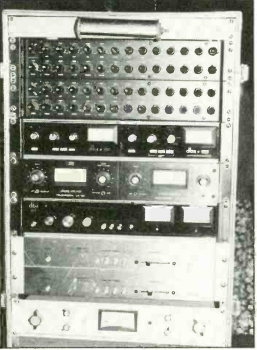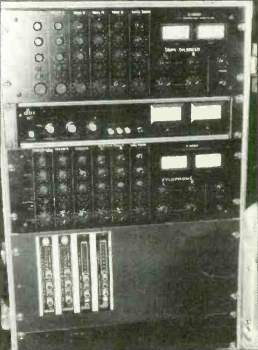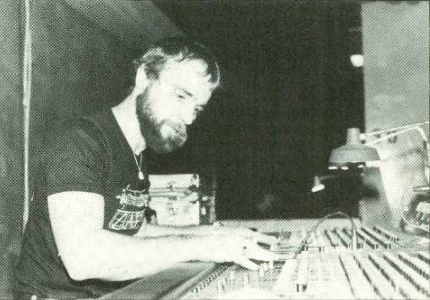Frank Zappa Live
By David Clamage
On a long forgotten Mother's Day (in America the 2nd Sunday in May) through creation of The Mothers of Invention, one Frank Zappa did emerge upon the music scene (sic). And for something like 14 years he has continued to provide those who would care to listen, a style of music appropriately removed from the balance of that era ... and others.
A dissertation upon our guesses at his philosophy and commentaries would be just that – a guess; and as we rarely indulge in guessing I shall leave it out. But, it may be worthwhile to mention that with such an uncompromising standard of tone and composition, coupled with relevant 'social comment', it is not unusual to find that same standard prevalent in his pursuit of quality audio reproduction.
I was witness to the four Frank Zappa performance at the Hammersmith Odeon this January, and was able to spend time with his crew and technicians on their return at the end of February. It is note-worthy to add that our conversations took place during the set-up time for the stage and equipment, and hence many thanks are in order to all concerned for allowing me in their way. The offices of Frank Zappa and Frederick Bannister are to be thanked for their cooperation and time, as this article would not have been possible without their efforts.
Al Santos, the production chief greeted me upon my arrival at the Odeon and directed me to the appropriate staff and scene of activity. One comment to 'would-be' stage managers: here is a man dealing with the orchestration of a major performer on the road, who is not afraid of expending a little elbow-grease in the interest of a job well done. And I am sure that the ever present beret is not just to cover the well-earned bald spot.
As the snake was winding its way to the main mixing consoles I began my talks with David Gray, the man behind all the guitars, their effects and amplification. The most interesting piece of equipment must be the 'Blue Box' designed for Frank by Klaus Wiedemann. This is a free standing 483 mm rack of effects used by Frank's guitar, requiring David's full time attention.

Either side of the main pa desk there are racks of
power amps, equalisers and compressor-limiters;
this is the right-hand one.
As Frank uses no leads for his guitar, the signal is transmitted by much the same system as many advanced wireless mics. I was assured by David that, even at the most extreme distances, they've experienced no loss or degradation of signal. The signal is received at a pedalboard, used to select the desired effect or combination of effects, and travels the snake to the 'Blue Box'. It is then split into four independently controlled signals and met with buffer-amps to maintain signal integrity. The buffers do not make up for any deficiencies in signal, but merely ensure that the signal remains hot at the splitting process.
The signal is then sent to an Alembic preamp for the appropriate routing to the special effects module. Not unlike other equipment used by Frank, this has been modified to add an additional mono channel to encompass one additional effect, in this case a Harmonizer. The effects that are used in the 'Blue Box' read like one of our surveys: MXR Digital Delay, Big Muff Distortion, Space Echo, Eventide Harmonizer, Bi-Phase and dbx compression. Nearly every unit has been modified to new specifications by David or Klaus in order to attain matching with other components in the chain, or to alter the unit's function to arrive at the sound Frank had requested. These are all interfaced with other units in a jump-loop, with the signal waiting at each module so as to respond readily to the relay switching employed. It was mentioned at this point that many times 'we just used a bigger cap' to get around some of the obvious problems created by using that method. Other components included in the system are Burwen signal processors modified to encompass the broad range of signal inputs and various use- characteristics, with Kepex and Gain Brains generally used in a limiting mode. Watching the performances it could be seen that Frank is generally well into the triggering mode of the dbx compressor and my query found that that is part of the subtleties in sound that Frank prefers. (So there, to those who move in hate of these obedient devices.) And finally a complement of Clear Sound modules, again installed to ensure integrity of the signal.

The left-hand equipment rack.
Note the separate sub-mixer for drums and
various percussion, including gongs and
xylophone (!).
As I mentioned, the signal is split into four outputs, these being 'Dirty Left, Dirty Right and Clean Left, Clean Right' with vcas handling the control of intensity and blend. This splitting is arranged by a Yamaha 4X mixer in the rear, also allowing input of Frank's vocal mic for use of time-related effects and eq. Amplification is handled by a Mesa Boogie with the eq section modified by David for expanded range, and that is sent to the ever present Marshalls and on to the 4 x 12s.
Seeing and hearing the system in operation, and hearing the tasteful use of effects, the application of such an advanced unit came well into justification. Frank and his staff are so fussy about the system that I am told a regular re-patch of the modules is performed so as to search for the desired order of effects; ie trying out new combinations in pursuit of 'that right sound'.
Much to the delight of David Gray, the babysitter for this unit, not much servicing or addition of units has been done while on the road; though, I dare say he had sufficient test equipment and parts to undertake the most dramatic of operation, if necessary. In leaving David, less than an hour had transpired in our conversation and he was bringing out the guitars and preparing for a test of the entire system ... all 24 modules. And then he moved on to see to the gear used by the bassist and 2nd guitarist, looking after the actual instruments, as well. My next conversation was with Klaus Wiedemann and I found him making a repair to the power amps in one of the main speaker columns. I guess that Klaus is best described as one of genius calibre, having made the original design for the 'Blue Box' and now using his expertise on the pa itself. The drivers and cabinets are to remain unnamed as they are nearing replacement by a custom designed system. This will be commissioned by Frank for Klaus to design and construct, and this is sure to be studied when it makes its appearance. The basic system, now in use, is front-loaded bass-reflex cabinets with an array of high- frequency ring radiators and one mid-range horn per cabinet. Klaus complains of the relative ineffectiveness of the high frequency units, in comparison with other drivers in the system, and promises a better design in the future. The bins are fitted with individual crossover networks working fairly fast at 12 dB/octave, and though perhaps that rate may be a bit vicious it was quite effective with respect to the levels used.
The repair being carried out during our conversation turned out to be another wiring harness frailty, one that could well have been Davey Moire at the main pa desk of two Yamahas prevented by. the manufacturer. It is funny to find that a unit 'designed for road use' would seem to be conceived with the notion that the road is paved with cotton wool, when more often than not it seems to be rock and boulders. Each power amp in the entire set has been mounted on a new chassis as the weight of the mains transformers was found to rip to bankruptcy many fragile pcbs in the course of getting the stage from van to soundcheck in less than 4 hours. It was quite refreshing to see the abundance of preventive medicine used in this team, and their careful selection of replacement equipment and parts. That night alone a faulty crossover unit was removed from the cabinet and replaced with a similar model, even while the other unit had been consigned to the repair bench.
Klaus and I then discussed the mic techniques used as they seem to contradict most of the common thought in that area. I was informed that Frank had supervised most of the miking and used his ear as the guide, and not some ageing theory. Drums and percussion are given better attention than most studios allow; the percussion, drums and both keyboards are submixed at their stations by the player and engineer together, ensuring that greater subjective control remains with the musician, ie where it is most needed. During the concerts the separation and definition of sound was more precise than I'd thought the Odeon would allow-I noted especially that the bass drums and cymbols sounded like themselves, and not pounded cardboard boxes and dustbin lids. Further, each individual instrument that did utilise more then-ote input at the main desk, offered the opportunitya stereo mix. This effect was especially pleasing in the presence of the percussion section and drums, and it was a nice departure from the usual 'everything in mono, they can't hear it ' in stereo anyway' train of thought.

Davey Moire at the main pa desk of two Yamahas
Leaving Klaus to mutter something in German about bad crossovers I went on to Davey Moire, the man in charge of the main pa mix. Most of us will have seen Davey's name on the sleeve of many a disc emanating from the Record Plants in New York and LA, and he is even to be found on Frank's Zoot Allures lending a bit of vocal postulation. I have had close familiarity with Davey's work before (Tommy Bolin and others) and find that his goals of accuracy and creative control employed in the studio have certainly prevailed in the more immediate area of live- mixing. He sits at two Yamaha PM-1000s, modified to the specifications of Davey's and Frank's use.
It is interesting to note that a previously mentioned error in the panning pot section (see Review, STUDIO SOUND, December '76, p76) has been modified by the Zappa staff to correct that deficiency. Davey told me that the Yamahas were selected after much wrist wrenching with their previous desks, and they are most pleased with the transition. I was told many a story of their reliability and ease of operation including the one about the broken flight case resulting in only a set of four wheel dents on top. One of the key modifications was the addition of a group muting switch, usually employed in the vocal groups so as to allow the minimum of ambient noise to get to the mics not in circuit (for example, during instrumental passages). Here is another man not afraid to move faders in and out of use, even in a live situation, striving for as clean a sound as possible.
Davey interfaces all of the stage with the racks of ancillary equipment and mixer. Everything is miked except the keyboards, some percussion and the di output from the 'Blue Box'. He uses dbx compression for the entire system and several supplementary mixers to control percussion and drum outputs. Again Kepex and Gain Brain appear, though used sparingly and mostly for limiting purposes. It was found that the dynamic range of the music was more an inherent quality of the playing as opposed to engineering. Here would be the proper place to comment as to how quality sound can only make a mediocre band as good as they are mediocre; it makes an excellent band (ie Frank Zappa et al) brilliant.
Davey then sends four channels of information back to the bins and power amps, with the same mono /stereo mix going to four tracks at 76 cm/s on the venerable Scully. I was told that much of a live disc (absolutely in litigation) was made from that same 4-track machine with little or no overdubs. That shows just how thoroughly they operate.
During the soundcheck Davey and the separate monitor mixer take turns with the White pink-noise generator and their own White equaliser system. The live eq settings run quite flat, with a minor boost (3-5 dB) at the low and high ends, with a slight cut (3 dB) around 150 Hz, which was found to be the resonant frequency of the bins. Davey has discussed the possibility of incorporating pink-noise into the system after the room has filled with people. He feels that while he has established the bulk of his mix during the first three or four numbers, a more objective eq setting should be allowed for the compensation of variances, such as full or semi-full house conditions. During the dynamic eq process he is also adjusting for any hearing discrepancies that he or those in the area of the consoles may perceive, and recommends all of us to take the time for a professional hearing check. I could proudly state that mine was tested as recently as six months ago, while Davey was anxious after 18 weeks on the road!
During the actual performance I took time out to make an spl reading using a consumer test unit A-weighted; I found that the normal level was in the area of 95-100 dB, with few peaks above 110 dB. No one yelled to 'turn it up' and the sound filled the hall with good separation and clarity. (I took those measurements in a nasty bass trap, under the balcony at the mixing desk.)
All in all the music and quality of the sound were both a pleasure and learning experience. Frank Zappa travels with a most qualified entourage in Messrs Moire, Wiedemann and Gray and I am told that their efforts are treated with a spirit of creativity and autonomy, rarely found in such an environment.
But I think that I will close this story with an answer to an old question of mine. Back in the late Sixties Frank Zappa and The Mothers of Invention released a fine double-album set called Uncle Meat. The copious liner notes mentioned that one particular passage contained no less than 64 tracks of percussion and other instrumentation ... how so in '69? Four SMPTE edit code generators, 'I guess that's what keeps them in sync.'